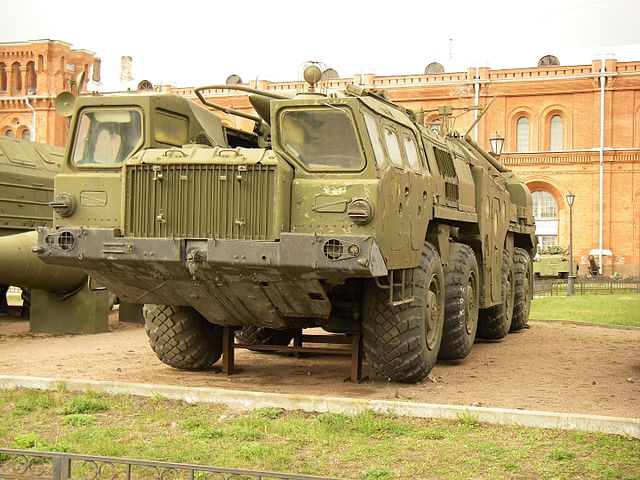A Scud missile is one of a series of tactical ballistic missiles developed by the Soviet Union during the Cold War. It was exported widely to both Second and Third World countries. The term comes from the NATO reporting name attached to the missile by Western intelligence agencies. The Russian names for the missile are the R-11, and the R-17 Elbrus. The name Scud has been widely used to refer to these missiles and the wide variety of derivative variants developed in other countries based on the Soviet design.
Scud launcher, picture taken at RAF Spadeadam, England
MAZ-543 (9P117) Launcher with 8K14 rocket of 9K72 missile complex "Elbrus" (Scud B), Saint-Petersburg Artillery Museum, Russia. (2007)
The rear section of an 8K14 missile, displayed at the Poznan Museum of Armaments - pl:Muzeum Uzbrojenia w Poznaniu, Poland. The fixed fins and the graphite vanes that control the missile's path can be seen
Scud Transporter Erector Launcher (TEL) with missile in upright position, RAF Spadeadam, England (2005)
Tactical ballistic missile
A tactical ballistic missile (TBM), or battlefield range ballistic missile (BRBM), is a ballistic missile designed for short-range battlefield use. Typically, range is less than 300 kilometres (190 mi). Tactical ballistic missiles are usually mobile to ensure survivability and quick deployment, as well as carrying a variety of warheads to target enemy facilities, assembly areas, artillery, and other targets behind the front lines. Warheads can include conventional high explosive, chemical, biological, or nuclear warheads. Typically tactical nuclear weapons are limited in their total yield compared to strategic nuclear weapons.
The MGM-140 ATACMS tactical ballistic missile firing




